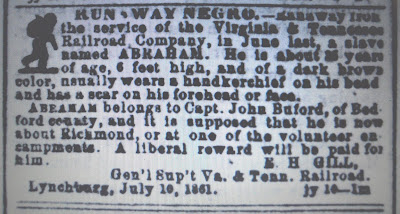Petersburg's commercial community had long desired a western route, one that could bring primarily tobacco, but other crops such as wheat, from that region of the state. Before a viable rail line Petersburg had primarily relied on the Appomattox River and its canal which circumvented the fall line to get the tobacco from more inland towns such as Farmville. Petersburg's desired were met when the Southside Railroad was chartered in 1846. The 123 mile route from Petersburg to Lynchburg reached completion in 1854.
This route also provided travelers with a way to get to western locales. From Petersburg, train-bound passengers could ride the cars to Lynchburg and from there continue west to Knoxville, Chattanooga, Memphis, or Atlanta on the Tennessee and Virginia and Tennessee and Georgia parts of the connector lines.
Of course, a majority of the labor required to build Petersburg's railroads came from enslaved workers. Major railroad contractors placed advertisements seeking to both purchase and lease surplus slaves from area owners and brokers to do the grueling work of grading railroad beds, sawing and placing timber ties, and laying iron track. The General Superintendent of the Virginia and Tennessee Railroad, which was a connector line to the Southside Railroad in Lynchburg, posted the above advertisement seeking to locate a runaway slave named Abraham, who was rented from his owner to work on the railroad. It is interesting that the superintendent suspected that Abraham may be attempting to gain some anonymity at one of the Confederate encampments around Richmond.
The Southside Railroad was Gen. Grant's final objective, as it was the last supply artery of Lee's army at Petersburg. Grant's Eighth Offensive (March 29-April 1), which included actions at Lewis Farm, White Oak Road, Dinwiddie Courthouse, and Five Forks, snapped the Boydton Plank Road and put Federal forces within striking distance of the Southside Railroad. The Federals finally severed the line on April 2, 1865, when the VI Corps broke through Lee's thinly defended line at what is now Pamplin Historical Park. Some of the troops who broke through made their way to the Southside Railroad and tore up track. In fighting later in the day at Sutherland Station, more track was captured and secured. The Southside Railroad Depot in Petesburg (shown above) came under Union control on the morning of April 3.
During the Appomattox Campaign the Southside Railroad was re-gauged by Union soldiers in the IX Corps to fit their Military Railroad rolling stock. Doing so allowed them to use old Confederate infrastructure such as the bridge over Rohoic Creek shown above without having to build new structures. These efforts helped supply elements of the Union army as it pursued Lee westward. The Southside Railroad ran through Appomattox Station, near Appomattox Courthouse, where Grant forced Lee's surrender on April 9.












Your story was very useful to me as I work on my family's genealogy. I found a reference in the Petersburg City Directory, 1872-73 - on Page 104
ReplyDeleteNugent Robert, Nugent’s al nr S. S. R. R. I Googled SSRR & Petersburg VA and found your story with the great history and pictures. Thank you!